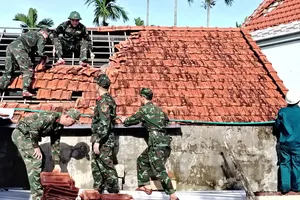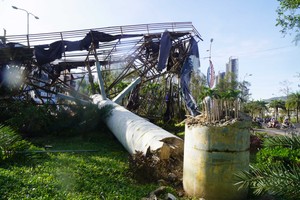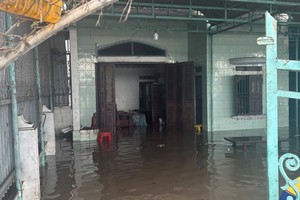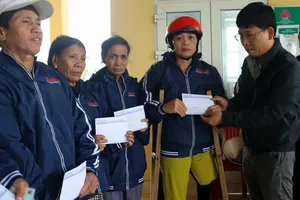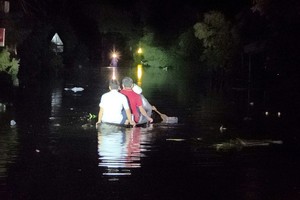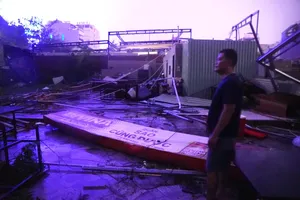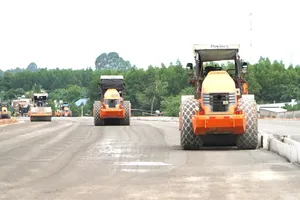
Following a night of violent winds and relentless rain, coastal villages in Quang Ngai, Gia Lai, and Dak Lak were left devastated.
Roofs were blown off, walls laid in rubble, and sea sand covered porches. Heavy rain and rising tides swept away much of the residents’ belongings.
Residents thought they would not survive
Yesterday morning, after typhoon Kalmaegi - the country’s storm No. 13 - had passed, the coastal village of Tinh Khe in Quang Ngai Province looked desolate. Along An Ky Hamlet, shattered roof tiles covered the ground, trees lay broken, and thick layers of sand blanketed courtyards.
Nguyen Thi Dao, a local resident, recalled in shock: “The waves were unusually high, the water rose half a meter, sand covered the entire yard, and even the concrete fences collapsed.”
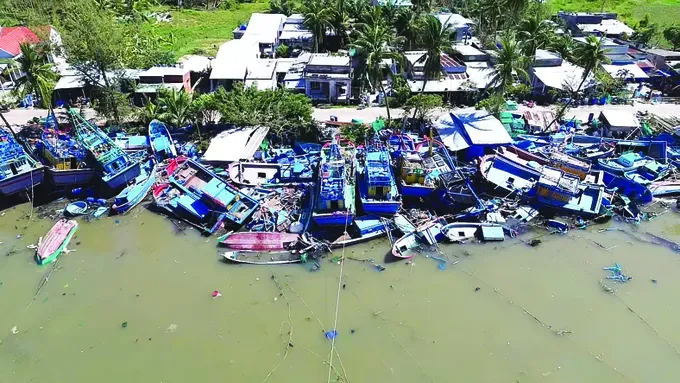
According to Chairman Nguyen Quoc Vuong of the Tinh Khe Commune People’s Committee, around 1,000 households live along the 10 km coastline. Of these, 157 homes were damaged, with losses estimated at VND25 billion (US$954,351).
In Quy Nhon of Gia Lai Province, powerful winds tore through beachfront shops and hotels. Along An Duong Vuong, Nguyen Tat Thanh, and Xuan Dieu streets, uprooted trees and broken signboards littered the roads.
Ha Thi Cam Van, owner of two restaurants, stood in disbelief before the wreckage. She moaned that the damage exceeds VND4 billion and she has no idea how to start over.
Nearby in Tuy Phuoc Commune, the small house of Nguyen Thi Lan, 58, by Thi Nai Lagoon, was reduced to rubble. In tears, she said: “I spent years saving to repair this home. Now the storm took it all—everything’s gone.”
Next door, the home of Do Trong Anh, 62, was also destroyed. He remembered that his two sons and he had to run between the storm and the rising tides. As a result, they had to hide under the table from flying metal sheets, then climbed higher to escape the floodwaters. That night, they ran from both storm and flood.
In Xuan Thanh fishing village of Gia Lai Province’s Phu My Dong Commune, dozens of houses were flattened or stripped of their roofs, and the coastal embankment was smashed by waves.
In De Gi Commune, homes, shops, and the aquaculture farms of Viet Uc Cooperative were all ripped apart by the sea.
The scene in Dak Lak Province’s Song Cau Commune was equally tragic. Trees and electric poles lay scattered, corrugated iron sheets and signboards flew everywhere. Resident Nguyen Thi Ut sat by the shore looking out to sea, her voice choking: “My husband and I raised 25,000 tiger prawns, planning to sell them during Tet, but the storm destroyed everything.”
Beside her, Mr. Lieu An struggled to patch the roof, while his son rented a boat to search for the fishing vessel swept away by the waves. Without the boat, their livelihood was gone.
Heading back to xa Tuy An Bac in Dak Lak Province, many roads remained deeply flooded, and some residential areas were isolated. Ms. Nguyen Thanh Nga said her family had evacuated since the afternoon of November 6, but still could not return home because water from the La Hien 2 hydropower plant had risen high. Local authorities were urgently providing support, relocating residents to safe areas, ensuring no loss of life.
All forces mobilized to help storm victims
In the aftermath of typhoon Kalmaegi, soldiers, police, and local officials across Quang Ngai, Gia Lai, and Dak Lak are working tirelessly to rebuild homes, restore electricity, and help residents return to normal life.
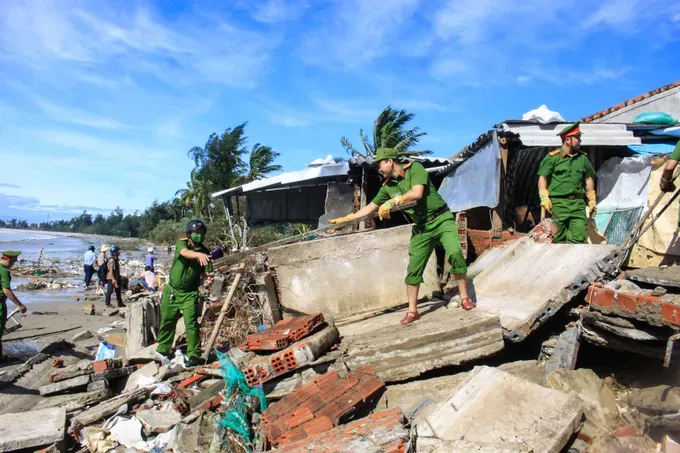
Yesterday morning, as the rain subsided, more than 50 officers and soldiers from the Rapid Response Unit of the Quang Ngai Provincial Military Command arrived in Long Phung Commune. The tornado on the night of November 6 had torn the roofs off 45 houses and swept away many belongings. Amid the wreckage, young soldiers patiently re-roofed homes, replaced broken tiles, and cleared debris to help residents regain stability.
In western Quang Ngai—particularly in the communes of Mang Ri, Tu Mo Rong, Ngoc Linh, and Dak Sao—strong gusts damaged and unroofed hundreds of houses. Dak Sao suffered the heaviest losses, with about 100 homes damaged and many Xo Dang ethnic families forced to take temporary shelter.
Vice Chairman of Dak Sao Commune People’s Committee, Nguyen Thanh Thuy, said: “We mobilized over 100 officials, militia, and security teams to 17 villages to help residents repair their homes. For families in difficulty, the commune advanced roofing sheets and nails for immediate use. By 3 p.m. on November 7, we had repaired about 80 percent of the damaged houses.”
In Gia Lai, from early morning, thousands of military personnel, police officers, and local workers joined hands to repair the damage left by the typhoon. Around Quy Nhon, more than 500 urban workers, along with soldiers and police, cleared fallen trees, unclogged drains, and re-erected broken signboards.
At schools, teachers and parents swept classrooms and repaired desks to welcome students back as soon as possible.
Director Thai Minh Chau of Gia Lai Power Company, reported that the typhoon damaged 8,483 electrical substations, cutting power to nearly 977,000 households.
On the afternoon of November 7, Major General Luong Dinh Chung, Secretary of the Party Committee and Political Commissar of Military Region 5, led a delegation to Gia Lai to visit affected families and oversee recovery efforts.
Chairman Pham Anh Tuan of the Gia Lai Provincial People’s Committee, instructed local authorities to mobilize all available forces to ensure “no resident goes hungry or homeless, and no student misses school for long.”
The province prioritized restoring essential infrastructure—transportation, hospitals, and schools—with a goal of completion before November 10.
According to the National Center for Hydrometeorological Forecasting, after making landfall in the South Central Coast and Central Highlands mainly Gia Lai, Dak Lak, and Quang Ngai, the typhoon weakened into a tropical depression over southern Laos on the morning of November 7.
Transportation systems across the Central and Central Highlands regions suffered severe damage. Many provincial and rural roads were flooded or collapsed. In Gia Lai, the Dak Po To Bridge on the Truong Son Dong route lost one abutment, about 25 meters long and eight meters deep, due to flash floods.
In Dak Lak, National Highway 19C and several provincial roads, as well as parts of the North–South railway, were blocked by landslides and flooding.
Power companies reported 449 broken utility poles. A total of 1,603,637 customers lost electricity, and by the afternoon of November 7, service had been restored to 315,016 of them, while Gia Lai continued to face widespread outages.


